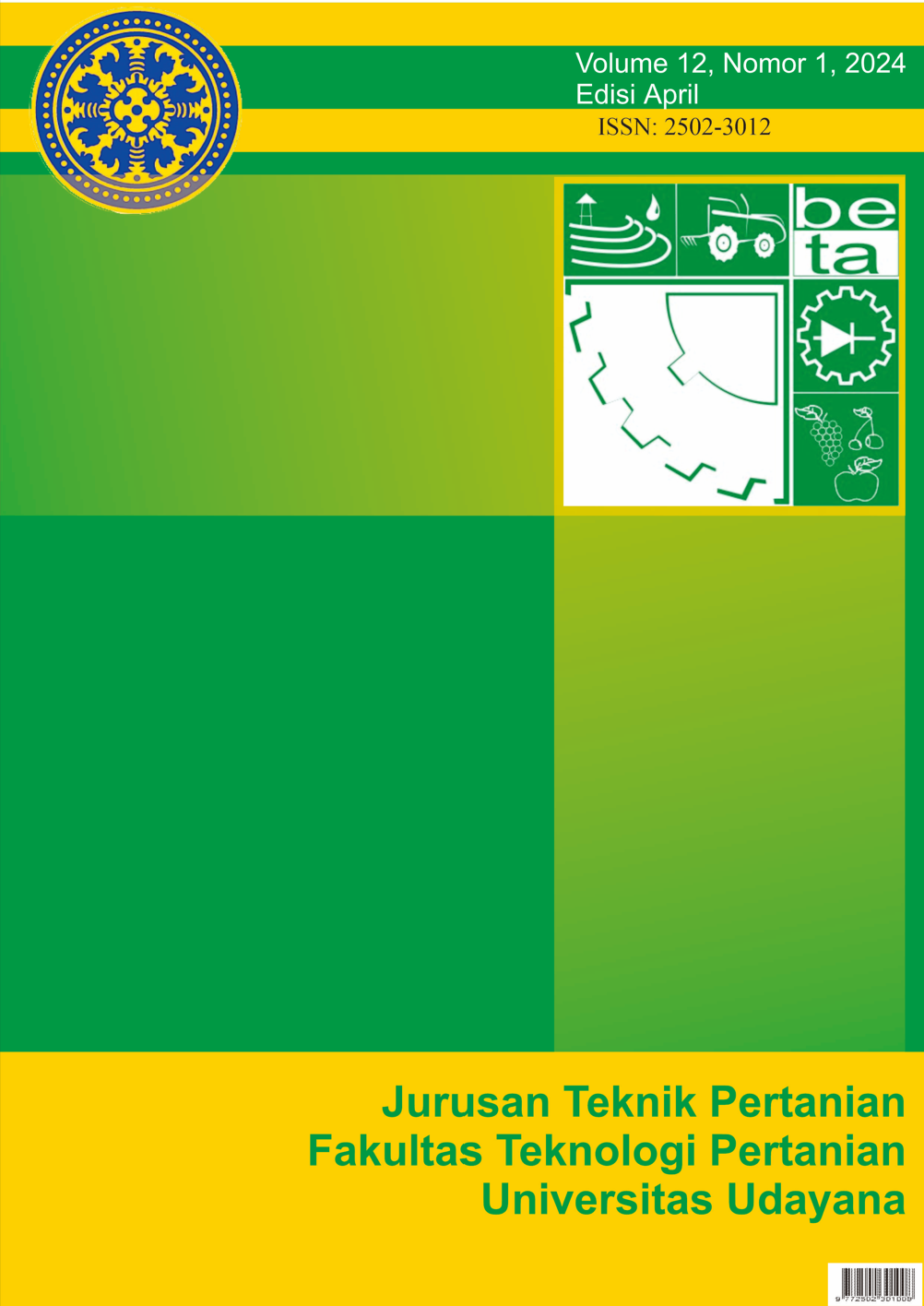Pengaruh Perlakuan Pre-sowing dan Fertigation Regime terhadap Produktivitas Microgreen Lobak (Raphanus Sativus)
Abstract
Microgreen merupakan tanaman hijau yang dipanen pada usia muda yang dihasilkan dari benih sayuran dari berbagai jenis sayuran yang biasa dikonsumsi oleh masyarakat umum. Pemeliharaan tanaman microgreen yang tidak membutuhkan lahan luas menjadi salah satu solusi teknik budidaya tanaman modern. Tanaman lobak memiliki kandungan nutrisi yang lebih tinggi jika dikonsumsi dalam bentuk microgreen. Tujuan dari penelitian ini adalah untuk mengetahui pengaruh kombinasi perlakuan pre-sowing dengan fertigation regime dan menentukan kombinasi perlakuan yang menghasilkan produktivitas microgreen terbaik. Rancangan percobaan yang digunakan dalam penelitian ini adalah Rancangan Acak Kelompok (RAK) dengan dua faktor yaitu perlakuan pre-sowing dan fertigation regime dengan 3 kali ulangan. Hasil dari penelitian yang telah dilakukan yaitu kombinasi perlakuan pre-sowing dan fertigation regime berpengaruh nyata terhadap berat basah dan berat kering microgreen, dan tidak berpengaruh nyata terhadap tinggi tanaman dan kandungan klorofil tanaman microgreen lobak. Kombinasi perlakuan pre-sowing direndam dengan fertigasi setiap hari memiliki rata-rata tertinggi pada setiap variabel yang diamati yaitu tinggi tanaman 9,49 cm, jumlah kandungan klorofil 45,99 SPAD, berat basah 108,70 gram, dan berat kering tanaman 9,70 gram. Berdasarkan hasil penelitian, kombinasi perlakuan pre-sowing direndam dengan pemberian fertigasi setiap hari pada microgreen lobak merupakan perlakuan yang menghasilkan produktivitas microgreen terbaik.
ABSTRACT
Microgreen are green plants that are harvested at a young age which are produced from vegetable seeds from various types of vegetables commonly consumed by the general public. Maintenance of microgreen plants that do not require large areas of land is one of the solutions for modern plant cultivation techniques. Radish plants have a higher nutritional content when consumed in the form of microgreen. The purpose of this study was to determine the effect of the pre-sowing treatment combination with the fertigation regime and to determine the treatment combination that produces the best microgreen productivity. The experimental design used in this study was a randomized block design (RBD) with two factors, namely the pre-sowing treatment and the fertigation regime with 3 replications. The results of the research that has been done are that the combination of pre-sowing treatment and fertigation regime has a significant effect on fresh weight and dry weight of microgreen, and has no significant effect on plant height and chlorophyll content of radish microgreen plants. The combination of pre-sowing treatment soaked with fertigation every day had the highest average for each variable observed, namely plant height 9.49 cm, total chlorophyll content 45.99 SPAD, fresh weight 108.70 grams, and plant dry weight 9.70 grams. Based on the results of the study, the combination of pre-sowing soaked treatment with daily fertigation of radish microgreens was the treatment that produced the best microgreen productivity.
Downloads
References
Allegretta, I., Gattullo, C. E., Renna, M., Paradiso, V. M., & Terzano, R. (2019). Rapid multi-element characterization of microgreens via total-reflection X-ray fluorescence (TXRF) spectrometry. Food Chemistry, 296, 86–93. https://doi.org/10.1016/j.foodchem.2019.05.187
Barus, W. A., Khair, H., & Pratama, H. P. (2020). Karakter Pertumbuhan Dan Hasil Tanaman Lobak ( Raphanus sativus L .) Terhadap Aplikasi Aampas Tahu Dan POC Daun Gamal. Agrium, 22(3), 183–189.
Delian, E., Lupu, C., & Săvulescu, E. (2018). Effect of different priming treatments on seeds germination and early seedlings growth of tomato. Current Trends in Natural Science, 7(13), 38–46.
Haryadi, D., Yetti, H., Yoseva, S. (2016). Pengaruh pemberian beberapa jenis pupuk terhadap pertumbuhan dan produksi tanaman kailan (Brassica alboglabra L.). 18(2), 33-37.
Idrus, H. A., & Fuadiyah, S. (2021). Uji Coba Imbibisi pada Kacang Kedelai ( Glycine max ) dan Kacang Hijau ( Vigna radiata ). Prosiding SEMNAS BIO 2021, 1(4), 710–716.
Kaliky, F., & Ohorella, S. (2011). Biomassa dan Karbon dibawah Permukaan Tanah Tegakan Sengon (Paraserianthes falcataria L. Nielsen) pada Lahan Agroforestry. Jurnal Agrohut, 2(2), 110–118.
Kalsumy, U., & Nihayati, E. (2018). Pengaruh Interval Fertigasi dan Perbedaan Media Tanam Terhadap Pertumbuhan dan Hasil Tomat Cherry (Lycopersicum cerasiformae Mill .) dengan Sistem Hidroponik. Jurnal Produksi Tanaman, 6(11), 2903–2909.
Li, T., Lalk, G. T., Arthur, J. D., Johnson, M. H., & Bi, G. (2021). Shoot production and mineral nutrients of five microgreens as affected by hydroponic substrate type and post-emergent fertilization. Horticulturae, 7(6). https://doi.org/10.3390/horticulturae7060129
Li, T., Lalk, G. T., & Bi, G. (2021). Fertilization and pre-sowing seed soaking affect yield and mineral nutrients of ten microgreen species. Horticulturae, 7(2), 1–16. https://doi.org/10.3390/horticulturae7020014
Murphy, C. J., Llort, K. F., & Pill, W. G. (2010). Factors affecting the growth of microgreen table beet. International Journal of Vegetable Science, 16(3), 253–266. https://doi.org/10.1080/19315261003648241
Pandita, V. K., Anand, A., Nagarajan, S., Station, R., & Delhi, N. (2007). Enhancement of seed germination in hot pepper following presowing treatments. 282–290.
Ranjan, S., & Sow, S. (2021). Fertigation: An efficient means for fertilizer application to enhance nutrient use efficiency. Food and Scientific Reports, 2(5), 24–26.
Salim, M. A. (2021). Budidaya Microgreens : Sayuran Kecil Kaya Nutrisi dan Menyehatkan (D. Setiawan (ed.)). Yayasan Lembaga Pendidikan dan Pelatihan Multiliterasi.
Tarigan, M. S., Barus, A., Silitonga, S., & Manik, F. (2012). Respon Pemberian Pupuk Organik Cair Dan NPK Pada Tanaman Biwa ( Eriobotrya japonica Lindl. ) DI Main Nursery. Edible Medicinal And Non-Medicinal Plants, 2(2337), 381–394. https://doi.org/10.1007/978-94-007-4053-2_46












 Jurnal BETA (Biosistem dan Teknik Pertanian)
Jurnal BETA (Biosistem dan Teknik Pertanian)


